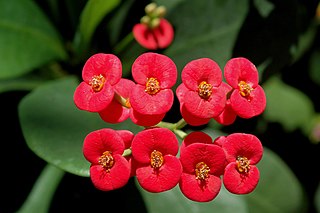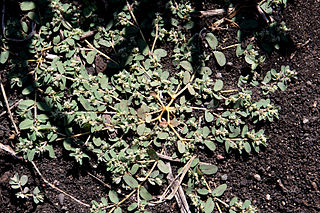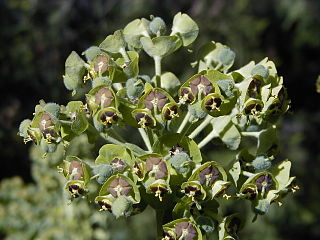
Euphorbia is a very large and diverse genus of flowering plants, commonly called spurge, in the family Euphorbiaceae. "Euphorbia" is sometimes used in ordinary English to collectively refer to all members of Euphorbiaceae, not just to members of the genus.

The poinsettia is a commercially important flowering plant species of the diverse spurge family Euphorbiaceae. Indigenous to Mexico and Central America, the poinsettia was first described by Europeans in 1834. It is particularly well known for its red and green foliage and is widely used in Christmas floral displays. It derives its common English name from Joel Roberts Poinsett, the first United States minister to Mexico, who is credited with introducing the plant to the US in the 1820s. Poinsettias are shrubs or small trees, with heights of 0.6 to 4 m. Though often stated to be highly toxic, the poinsettia is not dangerous to pets or children. Exposure to the plant, even consumption, most often results in no effect, though it can cause nausea, vomiting, or diarrhea.

Euphorbia esula, commonly known as green spurge or leafy spurge, is a species of spurge native to central and southern Europe, and eastward through most of Asia north of the Himalaya to Korea and eastern Siberia.

In botany, a bract is a modified or specialized leaf, especially one associated with a reproductive structure such as a flower, inflorescence axis or cone scale. Bracts are usually different from foliage leaves. They may be smaller, larger, or of a different color, shape, or texture. Typically, they also look different from the parts of the flower, such as the petals or sepals. A plant having bracts is referred to as bracteate or bracteolate, while one that lacks them is referred to as ebracteate and ebracteolate, without bracts.

Euphorbia amygdaloides, the wood spurge, is a species of flowering plant in the family Euphorbiaceae, native to woodland locations in Europe, Turkey and the Caucasus. It is a bushy evergreen perennial, growing to a height of 80 cm (31 in), with dark green slightly hairy leaves about 6 cm (2 in) long. The complex green-yellow inflorescence (cyathium), typical of Euphorbia, appears in late spring and early summer.

Saint Patrick is one of Dominica's 10 administrative parishes. It is bordered by St. George, St. Luke and St. Mark to the west, and St. David to the north. It has an area of 84.4 km² (32.59 mi²), and has a population of 8,383.

Euphorbia milii, the crown of thorns, Christ plant, or Christ's thorn, is a species of flowering plant in the spurge family Euphorbiaceae, native to Madagascar. The species name commemorates Baron Milius, once Governor of Réunion, who introduced the species to France in 1821.

Euphorbia resinifera, the resin spurge, is a species of spurge native to Morocco, where it occurs on the slopes of the Atlas Mountains. The dried latex of the plant was used in ancient medicine. It contains resiniferatoxin, an extremely potent capsaicin analog tested as an analgesic since 1997.

Euphorbia peplus, is a species of Euphorbia, native to most of Europe, northern Africa and western Asia, where it typically grows in cultivated arable land, gardens and other disturbed land.

Euphorbia maculata, known as spotted spurge, prostrate spurge, milk purslane, or spotted sandmat, is a fast-growing annual plant in the family Euphorbiaceae. While it is native to North America, where it is a common garden and lawn weed in the United States, it has become a common introduced species throughout the world, including Europe, Japan, Korea, Australia, and New Zealand.

Tinyatoxin is an analog of the neurotoxin resiniferatoxin. It occurs naturally in Euphorbia poissonii.

Euphorbia poissonii, also known as Euphorbia poissoni and, incorrectly, as Euphorbia poisoni, is a highly irritant and toxic succulent member of the large and varied spurge family of plants. It is native to northern Nigeria, where local farmers extract its latex for use as a pesticide. Its powerfully irritant and pain-producing nature mandates use as a fencing plant. It is known to the Berom people of the Jos area as pyùlúp who transplant it to their compounds where it is regarded as protection against witchcraft.

Euphorbiaceae, the spurge family, is a large family of flowering plants. In English, they are also commonly called euphorbias, which is also the name of the type genus of the family. Most spurges, such as Euphorbia paralias, are herbs, but some, especially in the tropics, are shrubs or trees, such as Hevea brasiliensis. Some, such as Euphorbia canariensis, are succulent and resemble cacti because of convergent evolution. This family has a cosmopolitan global distribution. The greatest diversity of species is in the tropics; however, the Euphorbiaceae also have many species in nontropical areas of all continents except Antarctica.

Euphorbia prostrata is a species of spurge known by the common name prostrate spurge or prostrate sandmat.

Euphorbia hirta is a pantropical weed, originating from the tropical regions of the Americas. It is a hairy herb that grows in open grasslands, roadsides and pathways. It is widely used in traditional herbal medicine across many cultures, particularly for asthma, skin ailments, and hypertension. It is also consumed in herbal tea form as folk medicine for fevers in the Philippines, particularly for dengue fever and malaria.

Euphorbia characias, the Mediterranean spurge or Albanian spurge, is a species of flowering plant in the family Euphorbiaceae typical of the Mediterranean vegetation. It is an upright, compact evergreen shrub growing to 1.2 m tall and wide.
La Plaine is a parliamentary electoral district in Dominica. It includes the areas of Boetica, Delices and La Plaine. It came into effect in time for the 1975 Dominican general election. It has been represented by Cassandra Williams of the Dominica Labour Party since the 2022 general election.















